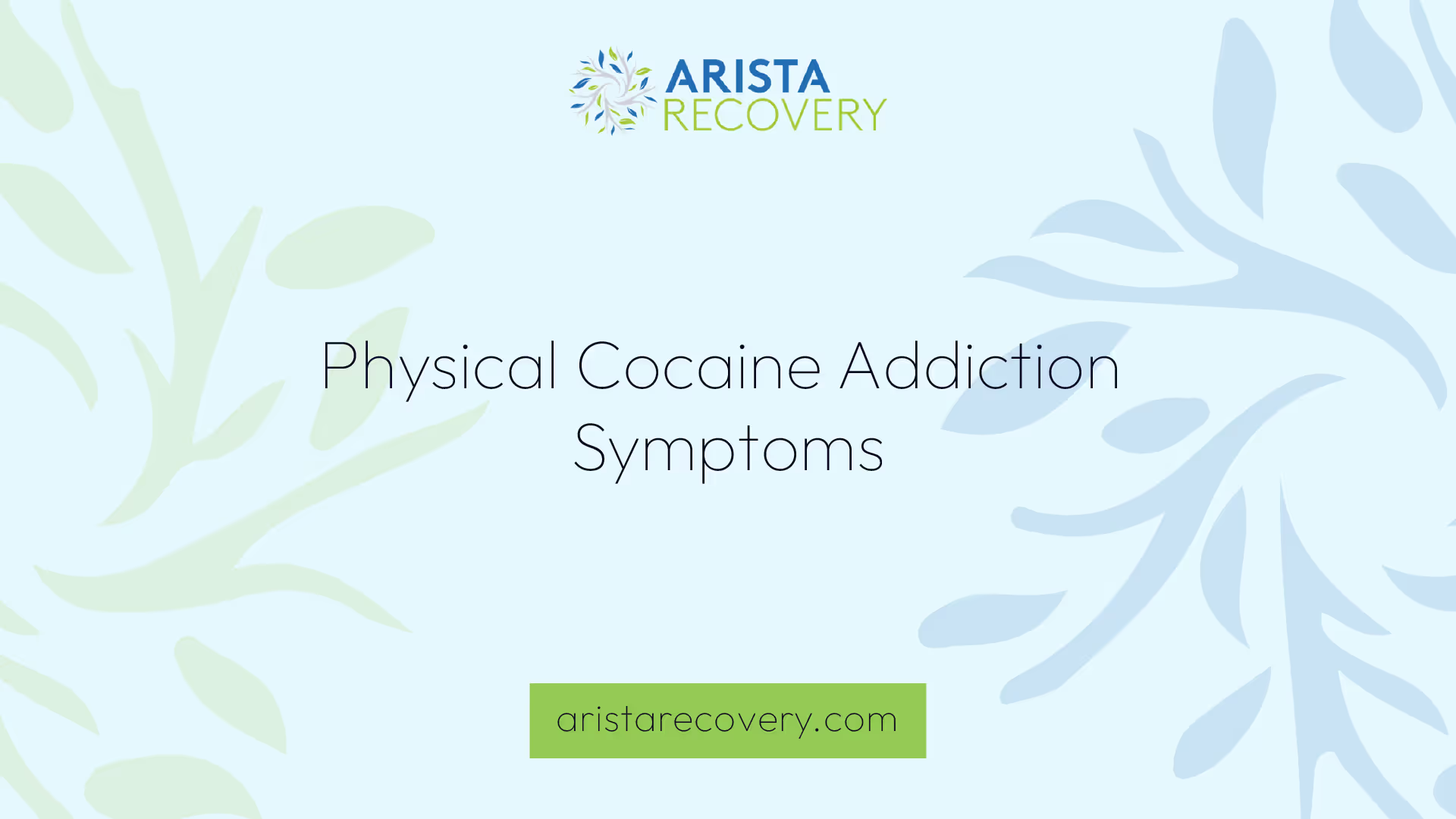Physical Cocaine Addiction Symptoms

Understanding Cocaine Addiction
Cocaine addiction is a serious issue that affects numerous individuals and their families. Recognizing the physical symptoms of cocaine addiction is a critical step towards seeking help and recovery.

Impact of Cocaine Use
Cocaine is a powerful stimulant that has significant effects on the body. Regular cocaine use is associated with increased systolic blood pressure, aortic stiffness, and left ventricular mass in young otherwise healthy individuals. This drug elevates blood pressure and heart rate, affecting how the heart functions in the short term. Prolonged cocaine use may cause long-term heart health issues including coronary artery disease, higher blood pressure, damage to the structure of the heart, heart arrhythmias, chest pain, congestive heart failure, heart attack, and stroke.
The impact of cocaine use is not limited to cardiovascular issues. Chronic cocaine use is also associated with reductions in body weight, specifically in fat mass, but not lean mass. This suggests a perturbation in fat regulation in cocaine-dependent individuals. Moreover, cocaine-dependent individuals report increased food intake, specifically in foods that are high in fat and carbohydrates, but there is no corresponding increase in body weight.
Physical Symptoms of Cocaine Addiction
Recognizing the physical symptoms of cocaine addiction is instrumental in seeking help and intervention. Here are some common physical symptoms associated with cocaine addiction:
- Rapid weight loss due to changes in fat regulation
- Increased heart rate and blood pressure
- Nosebleeds or runny nose (for those who snort cocaine)
- Burn marks on hands or lips (for those who smoke cocaine)
- Track marks (for those who inject cocaine)
- Chronic fatigue and exhaustion
- Neglect of personal hygiene
- Chronic headaches or migraines
- Chest pain or discomfort
The severity and frequency of these physical cocaine addiction symptoms can vary based on the duration and intensity of drug use. If these symptoms are observed, it is important to seek medical assistance immediately. In 2020, the SAMHSA Helpline received a total of 833,598 calls, which marked a 27 percent increase from the previous year, 2019, when 656,953 calls were received. This significant increase highlights the urgency and necessity of addressing cocaine addiction.
Cocaine's Effects on the Body
Cocaine, a powerfully addictive stimulant drug, has a profound impact on various body systems. Understanding these physical cocaine addiction symptoms can help identify and address the issue before it exacerbates. These effects span across different body systems, notably the cardiovascular, gastrointestinal, and dermatological systems.
Cardiovascular Effects
Cocaine's impact on the cardiovascular system is considerable and potentially life-threatening. As a stimulant, cocaine elevates blood pressure and heart rate, affecting heart function in the short term. Furthermore, regular cocaine use is associated with increased systolic blood pressure, aortic stiffness, and left ventricular mass in young, otherwise healthy individuals.
Long-term cocaine use may lead to enduring heart health issues, including:
- Coronary artery disease
- Higher blood pressure
- Damage to the structure of the heart
- Heart arrhythmias
- Chest pain
- Congestive heart failure
- Heart attack
- Stroke
Gastrointestinal Effects
Cocaine also affects the gastrointestinal system. Chronic cocaine abuse directly interferes with metabolic processes, resulting in an imbalance between fat intake and storage. This imbalance in active users could lead to excessive weight gain when the use of cocaine is discontinued during recovery [3].
Dermatological Effects
The use of cocaine also has negative effects on the skin. Direct contact between cocaine and the skin can cause dermatological issues such as dermatitis, eczema, and contact allergies. Regular cocaine users may experience symptoms like redness, itching, and inflammation on the skin [5].
Moreover, the vasoconstrictive properties of cocaine can lead to compromised blood flow to the skin, resulting in tissue damage and impaired wound healing.
These physical symptoms, alongside behavioral and psychological changes, can provide key indicators for recognizing a potential cocaine addiction. Prompt recognition and intervention can lead to effective treatment and recovery paths, mitigating the drug's harmful effects.
Behavioral and Psychological Symptoms
Alongside the physical cocaine addiction symptoms, the drug also induces profound behavioral and psychological changes in individuals. These changes can be quite noticeable and can significantly affect a person's quality of life and relationships.
Mood and Behavioral Changes
Behavioral and mood alterations are often among the first signs of a developing cocaine addiction. Individuals using cocaine often exhibit increased energy or activity levels, becoming overly talkative, excitable, erratic, and reckless. Some may become irrational, while others may display heightened sexual behavior. Extreme cases may even involve violent tendencies Addiction Center.
This drastic shift in behavior can be deeply distressing for both the affected individual and their loved ones. It's essential to recognize these signs early on and seek professional help to address the addiction and manage these behavioral changes.
Development of Psychosis
In addition to mood and behavioral changes, cocaine usage can give rise to severe psychological symptoms. One such symptom is the development of psychosis. Psychosis is a severe mental health disorder characterized by a disconnection from reality.
In the case of cocaine-induced psychosis, individuals may experience hallucinations and sensations of bugs crawling on or under their skin. This unsettling sensation often results in compulsive picking and scratching, leading to cuts, rashes, skin infections, and other skin diseases Bridges of Hope.
These psychological symptoms can be incredibly distressing and harmful. Early detection and treatment can significantly increase a person's chances of recovery and reduce the risk of long-term complications.
In conclusion, while the physical symptoms of cocaine addiction are often the most evident, it's crucial not to overlook the potential behavioral and psychological symptoms. By recognizing and addressing these symptoms, individuals struggling with cocaine addiction can receive the comprehensive care they need to overcome their addiction and regain control of their lives.
Cocaine Withdrawal Symptoms
Understanding the withdrawal symptoms associated with cocaine is crucial in identifying and addressing cocaine addiction. These symptoms are divided into physical and psychological categories, both of which can be severely challenging for the individual.
Physical Withdrawal Symptoms
When an individual ceases the use of cocaine, they may experience a series of physical withdrawal symptoms. These symptoms may not be externally visible but can include fatigue, lack of pleasure, anxiety, irritability, sleepiness, and sometimes agitation or extreme suspicion or paranoia. Cravings and depression can persist for months after stopping heavy, long-term use of cocaine [6].
Other physical symptoms of cocaine withdrawal may include restlessness, slowing down physically, increased appetite, and vivid, unpleasant dreams that can cause distress.
The physical symptoms of cocaine withdrawal can last for around seven days in the first stage of withdrawal, can continue for up to ten weeks in the second stage, and can persist for up to six months in the third stage after quitting cocaine [7].
Psychological Withdrawal Symptoms
While the physical symptoms of cocaine withdrawal are significant, the psychological symptoms can be equally challenging. During withdrawal, there can be powerful, intense cravings for the drug. Even as the pleasurable effects associated with cocaine use diminish over time, the cravings for cocaine can remain strong. The euphoria once experienced may be replaced by fear and extreme suspicion [6].
Withdrawal from chronic cocaine use can lead to serious complications, including the risk of suicide or overdose. Individuals experiencing cocaine withdrawal may turn to substances such as alcohol, sedatives, or anti-anxiety medications to manage their symptoms. However, long-term use of these substances is not recommended as it can lead to addiction to another substance.
Understanding these physical and psychological symptoms of cocaine withdrawal is crucial in identifying and addressing cocaine addiction. It is recommended to seek professional help when dealing with cocaine addiction, as the withdrawal process can be challenging and potentially dangerous if not properly managed.
Treatment for Cocaine Addiction
Treating cocaine addiction is a challenging task that requires a comprehensive and customized approach. While managing withdrawal symptoms is the first step, a holistic treatment plan and addressing any underlying mental health conditions are also critical.
Withdrawal Management
The first phase in treating cocaine addiction involves managing withdrawal symptoms. Due to the physical cocaine addiction symptoms and the high risk of suicide or overdose, proper medical supervision during withdrawal is essential [6]. This phase typically starts with outpatient care, which has been shown to be as effective as inpatient care for most individuals. Currently, there are no specific medications available to reduce cravings for cocaine. However, research is ongoing to develop such medications to assist in the recovery process.
Holistic Treatment Approaches
Following medical detoxification, successful treatment for cocaine addiction should include a holistic approach that addresses both the physical and the psychological aspects of the illness [7]. This may include behavioral changes, rebuilding social skills, forming healthy relationships, and attending support groups. These strategies aim to create a supportive environment that encourages recovery and reduces the risk of relapse.
Addressing Underlying Mental Health Issues
Often, individuals battling cocaine addiction may also suffer from underlying mental health issues – a condition known as dual diagnosis. According to Delamere, the simultaneous treatment of these mental health issues or trauma is critical to the successful treatment of cocaine addiction. This approach not only addresses the addiction itself but also the root cause, increasing the chances of a successful and sustained recovery.
In conclusion, treating cocaine addiction is a complex process that requires a comprehensive approach. By managing withdrawal symptoms, employing a holistic approach, and addressing underlying mental health issues, individuals battling cocaine addiction can make strides towards recovery and regain control of their lives.
References
[1]: https://www.ncbi.nlm.nih.gov/pmc/articles/PMC3981670/
[2]: https://www.medicalnewstoday.com/articles/cocaine-effects-on-heart
[3]: https://www.ncbi.nlm.nih.gov/pmc/articles/PMC3863945/
[4]: https://www.samhsa.gov/find-help/national-helpline
[5]: https://www.inspiremalibu.com/blog/drug-addiction/the-unseen-effects-of-cocaine-use-on-skin-health/
[6]: https://medlineplus.gov/ency/article/000947.htm
[7]: https://delamere.com/addiction-treatment/drugs/cocaine-addiction/withdrawal-symptoms
You’re not alone in this.
When mental health challenges and addiction intersect, it can feel isolating. At Arista, we offer compassionate, evidence-based, and trauma-informed care to help you heal, grow, and move forward.
You’re not alone in this.
When mental health challenges and addiction intersect, it can feel isolating. At Arista, we offer compassionate, evidence-based, and trauma-informed care to help you heal, grow, and move forward.
Support that moves with you.
You’ve taken a brave first step. At Arista Recovery, we’re here to help you continue with best-in-class care designed for long-term healing and support.
.webp)






